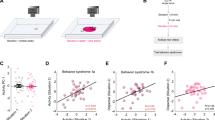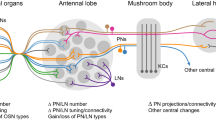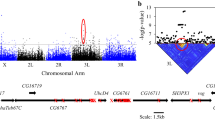Abstract
In the holometabolous insect Drosophila melanogaster, genetic, physiological and anatomical aspects of olfaction are well known in the adult stage, while larval stages olfactory behavior has received some attention it has been less studied than its adult counterpart. Most of these studies focus on olfactory receptor (Or) genes that produce peripheral odor recognition. In this paper, through a loss-of-function screen using P-element inserted lines and also by means of expression analyses of larval olfaction candidate genes, we extended the uncovering of the genetic underpinnings of D. melanogaster larval olfactory behavior by demonstrating that larval olfactory behavior is, in addition to Or genes, orchestrated by numerous genes with diverse functions. Also, our results point out that the genetic architecture of olfactory behavior in D. melanogaster presents a dynamic and changing organization across environments and ontogeny.




Similar content being viewed by others
References
Aceves-Piña EO, Quinn WG (1979) Learning in normal and mutant Drosophila larvae. Science 206(4414):93–96
Anholt RR, Mackay TF (2004) Quantitative genetic analyses of complex behaviours in Drosophila. Nat Rev Genet 5(11):838–849
Anholt RR, Lyman RF, Mackay TF (1996) Effects of single P-element insertions on olfactory behavior in Drosophila melanogaster. Genetics 143(1):293–301
Anholt RR, Dilda CL, Chang S, Fanara JJ, Kulkarni NH, Ganguly I, Rollmann SM, Kamdar KP, Mackay TF (2003) The genetic architecture of odor-guided behavior in Drosophila: epistasis and the transcriptome. Nat Genet 35(2):180–184
Arya GH, Weber AL, Wang P, Magwire MM, Negron YL, Mackay TF, Anholt RR (2010) Natural variation, functional pleiotropy and transcriptional contexts of odorant binding protein genes in Drosophila melanogaster. Genetics 186(4):1475–1485
Asahina K, Pavlenkovich V, Vosshall LB (2008) The survival advantage of olfaction in a competitive environment. Curr Biol 18(15):1153–1155
Ayer RK Jr, Carlson J (1991) acj6: a gene affecting olfactory physiology and behavior in Drosophila. Proc Natl Acad Sci U S A 88(12):5467–5471
Ayyub C, Paranjape J, Rodrigues V, Siddiqi O (1990) Genetics of olfactory behavior in Drosophila melanogaster. J Neurogenet 6(4):243–262
Bellen HJ, Levis RW, Liao G, He Y, Carlson JW, Tsang G, Evans-Holm M, Hiesinger PR, Schulze KL, Rubin GM et al (2004) The BDGP gene disruption project: single transposon insertions associated with 40 % of Drosophila genes. Genetics 167(2):761–781
Benton R, Vannice KS, Gomez-Diaz C, Vosshall LB (2009) Variant ionotropic glutamate receptors as chemosensory receptors in Drosophila. Cell 136(1):149–162
Boyle J, Cobb M (2005) Olfactory coding in Drosophila larvae investigated by cross-adaptation. J Exp Biol 208(18):3483–3491
Carreira VP, Mensch J, Fanara JJ (2009) Body size in Drosophila: genetic architecture, allometries and sexual dimorphism. Heredity 102(3):246–256
Carson HL (1971) The ecology of Drosophila breeding sites. University of Hawaii Foundation Lyon Arboretum Fund 32 p
Cobb M (1996) Genotypic and phenotypic characterization of the Drosophila melanogaster olfactory mutation Indifferent. Genetics 144(4):1577–1587
Cobb M, Dannet F (1994) Multiple genetic control of acetate-induced olfactory responses in Drosophila melanogaster larvae. Heredity 73:444–455
Cobb M, Domain I (2000) Olfactory coding in a simple system: adaptation in Drosophila larvae. Proc Biol Sci 267(1457):2119–2125
Cobb M, Bruneau S, Jallon JM (1992) Genetic and developmental factors in the olfactory response of Drosophila melanogaster larvae to alcohols. Proc Biol Sci 248(1322):103–109
Croset V, Rytz R, Cummins SF, Budd A, Brawand D, Kaessmann H, Gibson TJ, Benton R (2010) Ancient protostome origin of chemosensory ionotropic glutamate receptors and the evolution of insect taste and olfaction. PLoS Genet 6(8):e1001064
Dangles O, Irschick D, Chittka L, Casas J (2009) Variability in sensory ecology: expanding the bridge between physiology and evolutionary biology. Q Rev Biol 84(1):51–74
Del Pino F, Salgado E, Godoy-Herrera R (2012) Plasticity and genotype x environment interactions for locomotion in Drosophila melanogaster larvae. Behav Genet 42(1):162–169
Edwards AC, Zwarts L, Yamamoto A, Callaerts P, Mackay TF (2009) Mutations in many genes affect aggressive behavior in Drosophila melanogaster. BMC Biol 7:29
Fanara JJ, Robinson KO, Rollmann SM, Anholt RR, Mackay TF (2002) Vanaso is a candidate quantitative trait gene for Drosophila olfactory behavior. Genetics 162(3):1321–1328
Fishilevich E, Domingos AI, Asahina K, Naef F, Vosshall LB, Louis M (2005) Chemotaxis behavior mediated by single larval olfactory neurons in Drosophila. Curr Biol 15(23):2086–2096
Galindo K, Smith DP (2001) A large family of divergent Drosophila odorant-binding proteins expressed in gustatory and olfactory sensilla. Genetics 159(3):1059–1072
Ganguly I, Mackay TF, Anholt RR (2003) Scribble is essential for olfactory behavior in Drosophila melanogaster. Genetics 164(4):1447–1457
Gerber B, Stocker RF (2007) The Drosophila larva as a model for studying chemosensation and chemosensory learning: a review. Chem Senses 32(1):65–89
Hallem EA, Carlson JR (2006) Coding of odors by a receptor repertoire. Cell 125(1):143–160
Hallem EA, Dahanukar A, Carlson JR (2006) Insect odor and taste receptors. Annu Rev Entomol 51:113–135
Harbison ST, Yamamoto AH, Fanara JJ, Norga KK, Mackay TF (2004) Quantitative trait loci affecting starvation resistance in Drosophila melanogaster. Genetics 166(4):1807–1823
Harbison ST, Chang S, Kamdar KP, Mackay TF (2005) Quantitative genomics of starvation stress resistance in Drosophila. Genome Biol 6(4):R36
Heimbeck G, Bugnon V, Gendre N, Haberlin C, Stocker RF (1999) Smell and taste perception in Drosophila melanogaster larva: toxin expression studies in chemosensory neurons. J Neurosci 19(15):6599–6609
Hobert O (2008) Gene regulation by transcription factors and microRNAs. Science 319(5871):1785–1786
Kaiser M, Cobb M (2008) The behaviour of Drosophila melanogaster maggots is affected by social, physiological and temporal factors. Anim Behav 75:1619–1628
Keene AC, Waddell S (2007) Drosophila olfactory memory: single genes to complex neural circuits. Nat Rev Neurosci 8(5):341–354
Kreher SA, Kwon JY, Carlson JR (2005) The molecular basis of odor coding in the Drosophila larva. Neuron 46(3):445–456
Kreher SA, Mathew D, Kim J, Carlson JR (2008) Translation of sensory input into behavioral output via an olfactory system. Neuron 59(1):110–124
Laissue PP, Vosshall LB (2008) The olfactory sensory map in Drosophila. Adv Exp Med Biol 628:102–114
Lavagnino NJ, Fanara JJ (2011) Phenotypic plasticity for Drosophila melanogaster (Diptera: Drosophilidae) larval olfactory behaviour in response to whole fruit olfactory stimuli. Revista de la Sociedad Entomológica Argentina 70:369–372
Lavagnino NJ, Anholt RR, Fanara JJ (2008) Variation in genetic architecture of olfactory behaviour among wild-derived populations of Drosophila melanogaster. J Evol Biol 21(4):988–996
Lilly M, Carlson J (1990) smellblind: a gene required for Drosophila olfaction. Genetics 124(2):293–302
Lilly M, Kreber R, Ganetzky B, Carlson JR (1994) Evidence that the Drosophila olfactory mutant smellblind defines a novel class of sodium channel mutation. Genetics 136(3):1087–1096
Lukacsovich T, Asztalos Z, Awano W, Baba K, Kondo S, Niwa S, Yamamoto D (2001) Dual-tagging gene trap of novel genes in Drosophila melanogaster. Genetics 157(2):727–742
MacDonald JM, Beach MG, Porpiglia E, Sheehan AE, Watts RJ, Freeman MR (2006) The Drosophila cell corpse engulfment receptor draper mediates glial clearance of severed axons. Neuron 50(6):869–881
Masuda-Nakagawa LM, Gendre N, O’Kane CJ, Stocker RF (2009) Localized olfactory representation in mushroom bodies of Drosophila larvae. Proc Natl Acad Sci U S A 106(25):10314–10319
Matsunami H, Amrein H (2003) Taste and pheromone perception in mammals and flies. Genome Biol 4(7):220
Medina-Muñoz MC, Godoy-Herrera R (2005) Dispersal and prepupation behavior of Chilean sympatric Drosophila species that breed in the same site in nature. Behav Ecol 16(1):316–322
Mensch J, Lavagnino N, Carreira VP, Massaldi A, Hasson E, Fanara JJ (2008) Identifying candidate genes affecting developmental time in Drosophila melanogaster: pervasive pleiotropy and gene-by-environment interaction. BMC Dev Biol 8:78
Monte P, Woodard C, Ayer R, Lilly M, Sun H, Carlson J (1989) Characterization of the larval olfactory response in Drosophila and its genetic basis. Behav Genet 19(2):267–283
Moreau-Fauvarque C, Taillebourg E, Preat T, Dura JM (2002) Mutation of linotte causes behavioral defects independently of pigeon in Drosophila. NeuroReport 13(17):2309–2312
Norga KK, Gurganus MC, Dilda CL, Yamamoto A, Lyman RF, Patel PH, Rubin GM, Hoskins RA, Mackay TF, Bellen HJ (2003) Quantitative analysis of bristle number in Drosophila mutants identifies genes involved in neural development. Curr Biol 13(16):1388–1396
Oppliger FY, Guerin PM, Vlimant M (2000) Neurophysiological and behavioural evidence for an olfactory function for the dorsal organ and a gustatory one for the terminal organ in Drosophila melanogaster larvae. J Insect Physiol 46(2):135–144
Parsons PA (1980) Larval responses to environmental ethanol in Drosophila melanogaster: variation within and among populations. Behav Genet 10(2):183–190
Python F, Stocker RF (2002) Adult-like complexity of the larval antennal lobe of D. melanogaster despite markedly low numbers of odorant receptor neurons. J Comp Neurol 445(4):374–387
Rodrigues V (1980) Olfactory behavior of Drosophila melanogaster. In: Bvabu P, Hall LM, Hall JC (eds) Siddiqi O. Plenum Press p, Development and Neurobiology of Drosophila London, pp 361–372
Rollmann SM, Magwire MM, Morgan TJ, Ozsoy ED, Yamamoto A, Mackay TF, Anholt RR (2006) Pleiotropic fitness effects of the Tre1-Gr5a region in Drosophila melanogaster. Nat Genet 38(7):824–829
Rollmann SM, Yamamoto A, Goossens T, Zwarts L, Callaerts-Vegh Z, Callaerts P, Norga K, Mackay TF, Anholt RR (2007) The early developmental gene Semaphorin 5c contributes to olfactory behavior in adult Drosophila. Genetics 176(2):947–956
Ryuda M, Tsuzuki S, Tanimura T, Tojo S, Hayakawa Y (2008) A gene involved in the food preferences of larval Drosophila melanogaster. J Insect Physiol 54(10–11):1440–1445
Sambandan D, Yamamoto A, Fanara JJ, Mackay TF, Anholt RR (2006) Dynamic genetic interactions determine odor-guided behavior in Drosophila melanogaster. Genetics 174(3):1349–1363
Shaver SA, Varnam CJ, Hilliker AJ, Sokolowski MB (1998) The foraging gene affects adult but not larval olfactory-related behavior in Drosophila melanogaster. Behav Brain Res 95(1):23–29
StatSoft I. 2001. STATISTICA. A Data Analysis Software System. Release 6.0. Tulsa, OK
Su CY, Menuz K, Carlson JR (2009) Olfactory perception: receptors, cells, and circuits. Cell 139(1):45–59
Untergasser A, Nijveen H, Rao X, Bisseling T, Geurts R, and Leunissen JA (2007) Primer3Plus, an enhanced web interface to Primer3. Nucleic Acids Res 35(Web Server issue):W71-74
Vosshall LB (2000) Olfaction in Drosophila. Curr Opin Neurobiol 10(4):498–503
Vosshall LB, Stocker RF (2007) Molecular architecture of smell and taste in Drosophila. Annu Rev Neurosci 30:505–533
Yamamoto A, Zwarts L, Callaerts P, Norga K, Mackay TF, Anholt RR (2008) Neurogenetic networks for startle-induced locomotion in Drosophila melanogaster. Proc Natl Acad Sci U S A 105(34):12393–12398
Zhou S, Stone EA, Mackay TF, Anholt RR (2009) Plasticity of the chemoreceptor repertoire in Drosophila melanogaster. PLoS Genet 5(10):e1000681
Acknowledgments
The authors wish to thank T.F.C. Mackay (North Carolina State University, Raleigh, N.C., U.S.A.) for providing P[GT1] insertion lines and R. R. H. Anholt (North Carolina State University, Raleigh, N.C., U.S.A.) for comments on the manuscript. We also are grateful to F. Ceriani and G. Bernabó (Fundación Instituto Leloir, Buenos Aires, Argentina) for assistance with the GAL4/UAS-GFP system experiments. This work was supported by grants from Universidad de Buenos Aires, CONICET and NIH-Fogarty grant TW 007070. NJL is a recipient of a postdoctoral scholarship and JJF is a member of Carrera del Investigador Científico of CONICET (Argentina).
Author information
Authors and Affiliations
Corresponding author
Additional information
Edited by Yong-Kyu Kim.
Rights and permissions
About this article
Cite this article
Lavagnino, N.J., Arya, G.H., Korovaichuk, A. et al. Genetic Architecture of Olfactory Behavior in Drosophila melanogaster: Differences and Similarities Across Development. Behav Genet 43, 348–359 (2013). https://doi.org/10.1007/s10519-013-9592-z
Received:
Accepted:
Published:
Issue Date:
DOI: https://doi.org/10.1007/s10519-013-9592-z




